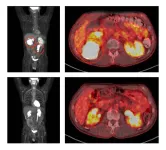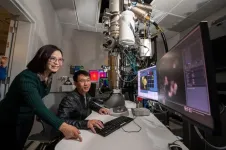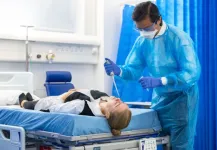(Press-News.org) Embargoed for Release
Wednesday, June 19, 2024
5:00 p.m. ET Contact: NCI Press Office
240-760-6600
NCIPressOfficers@nih.gov
NOTE: A virtual briefing is scheduled for Tuesday, June 18, 2024, at 1:00 p.m. ET. Details below.
Researchers at the National Institutes of Health (NIH) have developed a non-chemotherapy treatment regimen that is achieving full remissions for some people with aggressive B-cell lymphoma that has come back or is no longer responding to standard treatments. The five-drug combination targets multiple molecular pathways that diffuse large B-cell lymphoma (DLBCL) tumors use to survive.
In a clinical trial at NIH’s National Cancer Institute, researchers tested the combination of venetoclax, ibrutinib, prednisone, obinutuzumab, and lenalidomide (called ViPOR) in 50 patients with DLBCL, the most common type of lymphoma. The treatment shrank tumors substantially in 26 of 48 (54%) evaluable patients, with 18 (38%) of those patients’ tumors disappearing entirely, known as a complete response. At two years, 36% of all patients were alive and 34% were free of disease. These benefits were seen mainly in people with two specific subtypes of DLBCL.
The findings were published June 20, 2024, in the New England Journal of Medicine.
“Many of these patients who stopped responding to standard treatments would have otherwise died within a year, and now we have a good proportion who are still alive past two years, and some past four years,” said Christopher J. Melani, M.D., of NCI’s Center for Cancer Research, who co-led the study. “It’s gratifying to see these long-term remissions and potential cures in patients.”
Previous studies have identified various genetic pathways involved in the development and survival of the different molecular subtypes of DLBCL, such as activated B cell–like (ABC) DLBCL and germinal center B cell–like (GCB) DLBCL. Targeted drugs have shown effectiveness in blocking some of these pathways, but individual drugs rarely produced lasting responses in patients because the tumors may be resistant due to alternative survival pathways. Dr. Melani and his colleagues hypothesized that combining targeted drugs that block multiple survival pathways would lead to more durable responses.
Based on laboratory studies in which they analyzed which targeted drugs could best be combined to kill DLBCL cells in a synergistic manner, the researchers designed the five-drug regimen to test in human trials. To allow for the targeted drugs to work synergistically in patients, the researchers gave the drugs simultaneously in two-week cycles. To limit the accumulation of side effects, they scheduled a weeklong break between each cycle.
“DLBCL is one of the most genetically heterogeneous forms of cancer, and as a result we don't yet have the ability to identify exactly which combination of drugs would be most effective for any given patient,” Dr. Melani said. “By putting five drugs together, we believe that there will be some drug combination—either two, three, or more drugs—that will be particularly effective against that patient's tumor.”
In the phase 1b/2 trial, 50 people with DLBCL that had relapsed or stopped responding to treatment were given six cycles of the ViPOR regimen. Responses to ViPOR varied by DLBCL subtype, with complete responses concentrated in two subtypes, including in 8 of 13 (62%) people with non-GCB DLBCL and 8 of 15 (53%) people with a form of GCB DLBCL known as high-grade B-cell lymphoma “double hit.”
At two years, people with non-GCB DLBCL and double-hit GCB DLBCL had higher rates of both progression-free and overall survival than other people in the study. Non-GCB DLBCL and double-hit GCB DLBCL are highly reliant on the survival mechanisms targeted by ViPOR, so it makes sense that they responded particularly well to the combination therapy. ViPOR also helped 6 of 20 (30%) patients whose lymphomas had not responded to or had come back after CAR T-cell therapy—the current standard of care for people with relapsed DLBCL—achieve lasting remissions.
Side effects of the five-drug regimen were generally mild to moderate when compared with those of standard treatments and improved during the treatment breaks. Only five patients had to stop treatment early for various reasons, including side effects. Given these relatively mild to moderate side effects, additional drugs could potentially be added to ViPOR to improve its efficacy, the researchers said. The team is also studying the ViPOR regimen in people with other types of lymphoma that are resistant to previous therapies.
The researchers have developed a larger phase 2 study, which will be conducted at multiple centers, to confirm the activity of ViPOR in people with non-GCB DLBCL and double-hit GCB DLBCL. More work is needed to develop therapies for GCB DLBCL subtypes that aren’t as responsive to ViPOR.
NCI’s Center for Cancer Research investigators Wyndham H. Wilson, M.D., Ph.D., Mark Roschewski, M.D., and Louis M. Staudt, M.D., Ph.D., co-led the study with Dr. Melani. Investigators from NIH’s National Center for Advancing Translational Sciences and other institutions contributed to the study.
MEDIA BRIEFING
WHAT: Learn more about the results of the trial and ask questions of the study investigators from NCI’s Cancer for Cancer Research. The information from the media briefing is embargoed until Wednesday, June 19, 2023, at 5:00 p.m. ET. By registering and attending, you are agreeing to honor the embargo.
WHO:
• Christopher J. Melani, M.D.
• Wyndham H. Wilson, M.D., Ph.D.
• Mark Roschewski, M.D.
• Louis M. Staudt, M.D., Ph.D.
WHEN: Tuesday, June 18, 2024, at 1:00 p.m. ET
WHERE: Register at: ncipressofficers@nih.gov
Image caption: Before treatment with ViPOR, full-body and cross-sectional PET scans of a patient show large lymphoma tumors (circled in the top two panels). Following treatment, the tumors have disappeared (bottom two panels).
Credit: Center for Cancer Research/National Cancer Institute
###
About the National Cancer Institute (NCI): NCI leads the National Cancer Program and NIH’s efforts to dramatically reduce the prevalence of cancer and improve the lives of people with cancer. NCI supports a wide range of cancer research and training extramurally through grants and contracts. NCI’s intramural research program conducts innovative, transdisciplinary basic, translational, clinical, and epidemiological research on the causes of cancer, avenues for prevention, risk prediction, early detection, and treatment, including research at the NIH Clinical Center—the world’s largest research hospital. Learn more about the intramural research done in NCI’s Center for Cancer Research. For more information about cancer, please visit the NCI website at cancer.gov or call NCI’s contact center at 1-800-4-CANCER (1-800-422-6237).
About the National Institutes of Health (NIH): NIH, the nation's medical research agency, includes 27 Institutes and Centers and is a component of the U.S. Department of Health and Human Services. NIH is the primary federal agency conducting and supporting basic, clinical, and translational medical research, and is investigating the causes, treatments, and cures for both common and rare diseases. For more information about NIH and its programs, visit nih.gov.
END
Combination targeted treatment produces lasting remissions in people with resistant aggressive B-cell lymphoma
Combination therapy developed by NIH researchers demonstrates the power of precision medicine
2024-06-19
ELSE PRESS RELEASES FROM THIS DATE:
Common prostate drugs tied to lower risk of dementia with lewy bodies
2024-06-19
EMBARGOED FOR RELEASE UNTIL 4 P.M. ET, WEDNESDAY, JUNE 19, 2024
MINNEAPOLIS – Certain drugs used to treat urinary symptoms due to an enlarged prostate may be associated with a reduced risk of dementia with Lewy bodies, according to a study published in the June 19, 2024, online issue of Neurology®, the medical journal of the American Academy of Neurology. Dementia with Lewy bodies is a progressive neurodegenerative disorder that can cause memory and thinking issues, movement problems and issues such as hallucinations.
The results do not prove that these drugs reduce the risk of dementia ...
Drugs for enlarged prostate may also protect against dementia with Lewy bodies
2024-06-19
A new study suggests that certain drugs commonly used to treat enlarged prostate may also decrease the risk for dementia with Lewy bodies (DLB). This observational finding may seem surprising, but it mirrors previous work by the University of Iowa Health Care team that links the drugs to a protective effect in another neurodegenerative condition–Parkinson's disease.
The UI researchers think that a specific side effect of the drugs targets a biological flaw shared by DLB and Parkinson’s disease, as well as other neurodegenerative ...
Titan’s lakes may be shaped by waves
2024-06-19
Titan, Saturn’s largest moon, is the only other planetary body in the solar system that currently hosts active rivers, lakes, and seas. These otherworldly river systems are thought to be filled with liquid methane and ethane that flows into wide lakes and seas, some as large as the Great Lakes on Earth.
The existence of Titan’s large seas and smaller lakes was confirmed in 2007, with images taken by NASA’s Cassini spacecraft. Since then, scientists have pored over those and other images for clues to the moon’s mysterious ...
YALE EMBARGOED NEWS: Family psychiatric history: Effects on siblings of children with autism
2024-06-19
New Haven, Conn. — Children who have an older sibling with autism spectrum disorder (autism) are at greater risk of developmental vulnerabilities if they also have other relatives with neurodevelopmental or psychiatric conditions, according to a new study from the Yale Child Study Center.
Researchers found that the siblings of children with autism had an increase in the severity of social and communication difficulties — which are common in autism — if they had relatives with conditions such as schizophrenia or anxiety. Family histories of anxiety and intellectual disability were also associated ...
New technology provides electrifying insights into how catalysts work at the atomic level
2024-06-19
A team led by Lawrence Berkeley National Laboratory (Berkeley Lab) has invented a technique to study electrochemical processes at the atomic level with unprecedented resolution and used it to gain new insights into a popular catalyst material. Electrochemical reactions – chemical transformations that are caused by or accompanied by the flow of electric currents – are the basis of batteries, fuel cells, electrolysis, and solar-powered fuel generation, among other technologies. They also drive biological processes such as photosynthesis ...
Researchers create new class of materials called ‘glassy gels’
2024-06-19
Researchers have created a new class of materials called “glassy gels” that are very hard and difficult to break despite containing more than 50% liquid. Coupled with the fact that glassy gels are simple to produce, the material holds promise for a variety of applications.
Gels and glassy polymers are classes of materials that have historically been viewed as distinct from one another. Glassy polymers are hard, stiff and often brittle. They’re used to make things like water bottles or airplane windows. Gels – such as contact lenses – contain liquid and are soft and stretchy.
“We’ve created a class of materials ...
Tabulae Paralytica: Mapping the biology of spinal cord injury in unprecedented detail
2024-06-19
Scientists at EPFL have achieved a significant research milestone in the field of spinal cord injuries—mapping out the cellular and molecular dynamics of paralysis in unprecedented detail with their open-source project 'Tabulae Paralytica'. Grégoire Courtine and his team have integrated cutting-edge cell and molecular mapping technologies with artificial intelligence to chart the complex molecular processes that unfold in each cell after spinal cord injuries (SCI). Published in Nature, this seminal ...
When in drought: Researchers map which parts of the Amazon are most vulnerable to climate change
2024-06-19
In the late 2000s, Scott Saleska noticed something strange going on in the Amazon rainforest.
In 2005, a massive drought struck the region. Two years later, Saleska – a University of Arizona professor in the Department of Ecology and Evolutionary Biology – published surprising research that used satellite images to find that the drought resulted in more green growth in large swaths of the Amazon. On the other hand, field researchers saw plants brown and some die in response to the drought.
Research published today in the journal Nature reveals what caused the scientific mismatch. Shuli Chen, a doctoral degree candidate in ecology and evolutionary ...
Standardized OR handoffs significantly improve surgical communication and patient safety
2024-06-19
Key Takeaways
The introduction of a standardized handoff protocol substantially improved communication among OR staff, ensuring critical information was transferred consistently.
The enhanced communication reduced potential patient safety risks and highlighted the importance of standardized handoff tools in improving surgical outcomes.
CHICAGO (June 19, 2024) — A new study showcases a successful quality improvement program that significantly enhances surgical safety. By implementing a standardized handoff protocol, known as SHRIMPS, the study demonstrates how ...
Immune response study explains why some people don't get COVID-19
2024-06-19
Scientists have discovered novel immune responses that help explain how some individuals avoid getting COVID-19.
Using single-cell sequencing, researchers from the Wellcome Sanger Institute, University College London (UCL), Imperial College London, the Netherlands Cancer Institute and their collaborators, studied immune responses against SARS-CoV-2 infection in healthy adult volunteers, as part of the world's first COVID-19 human challenge study1. Not all exposed participants went on to develop a COVID-19 infection, ...
LAST 30 PRESS RELEASES:
When tropical oceans were oxygen oases
Positive interactions dominate among marine microbes, six-year study reveals
Safeguarding the Winter Olympics-Paralympics against climate change
Most would recommend RSV immunizations for older and pregnant people
Donated blood has a shelf life. A new test tracks how it's aging
Stroke during pregnancy, postpartum associated with more illness, job status later
American Meteorological Society announces new executive director
People with “binge-watching addiction” are more likely to be lonely
Wild potato follows a path to domestication in the American Southwest
General climate advocacy ad campaign received more public engagement compared to more-tailored ad campaign promoting sustainable fashion
Medical LLMs may show real-world potential in identifying individuals with major depressive disorder using WhatsApp voice note recordings
Early translational study supports the role of high-dose inhaled nitric oxide as a potential antimicrobial therapy
AI can predict preemies’ path, Stanford Medicine-led study shows
A wild potato that changed the story of agriculture in the American Southwest
Cancer’s super-enhancers may set the map for DNA breaks and repair: A key clue to why tumors become aggressive and genetically unstable
Prehistoric tool made from elephant bone is the oldest discovered in Europe
Mineralized dental plaque from the Iron Age provides insight into the diet of the Scythians
Salty facts: takeaways have more salt than labels claim
When scientists build nanoscale architecture to solve textile and pharmaceutical industry challenges
Massive cloud with metallic winds discovered orbiting mystery object
Old diseases return as settlement pushes into the Amazon rainforest
Takeaways are used to reward and console – study
Velocity gradients key to explaining large-scale magnetic field structure
Bird retinas function without oxygen – solving a centuries-old biological mystery
Pregnancy- and abortion-related mortality in the US, 2018-2021
Global burden of violence against transgender and gender-diverse adults
Generative AI use and depressive symptoms among US adults
Antibiotic therapy for uncomplicated acute appendicitis
Childhood ADHD linked to midlife physical health problems
Patients struggle to measure blood pressure at home
[Press-News.org] Combination targeted treatment produces lasting remissions in people with resistant aggressive B-cell lymphomaCombination therapy developed by NIH researchers demonstrates the power of precision medicine







